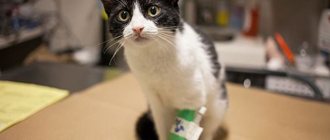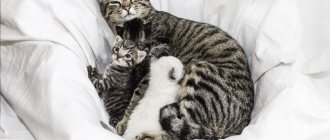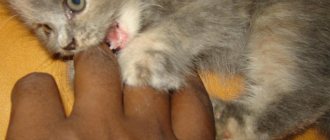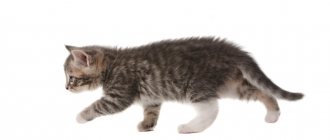How can you tell if your cat is about to give birth? This question is asked by any owner of a pregnant cat. Indeed, it is important to know that the cat is giving birth in order to have time to come to her aid and call a veterinarian in time in case of complications or a pathological course of labor.
Also, the presence of a person next to the cat giving birth for the first time is important. After all, young mothers, due to inexperience, often do not help the kittens breathe and do not lick them. Then the owner’s task is to clear the cubs’ airways from the amniotic membrane and wipe them with a damp cloth from mucus and blood.
How to prepare a cat for birth
A caring owner begins to prepare the cat for childbirth even before mating begins.
It is important to make sure that the pussy is healthy: an active lifestyle of the animal will contribute to the normal course of pregnancy and childbirth. However, towards the end of the term, it is better to ensure that the cat does not try to “take heights”, does not jump from cabinets and other high objects in the house: it can easily fall on its stomach.
On the contrary, you should try to stimulate British cats during pregnancy - these sloths are quite capable of lounging on the bed for a long period of time. And low mobility will not lead to a good result.
It is better to contact the veterinary clinic in advance and find out whether you can get an urgent consultation at any time of the day at “hour X”, and whether the institution provides the opportunity to give birth to cats at home .
Preparing the birth site
Just as a woman needs a breeding room, a cat needs a place to give birth to her offspring. It is best if it is something resembling a house for giving birth to a cat. In this place, not only will the fluffy balls be born, but also their first weeks of life will pass.
Why is it so important to prepare a place for your cat to give birth in advance? If she does not feel calm and protected, she will begin tossing around before the onset of labor, and then frantically dragging the kittens in search of a safe place.
How to help your beloved pussy during childbirth? Take care of everything in advance! What to make a house from: any spacious box will do, preferably with a removable top lid. A disposable absorbent diaper is placed in it. It makes sense to prepare in advance all the items that will help during obstetrics and place them close to the “maternity” house.
Best answers
VeroNika: Large explanatory dictionary:
LAMING – what to do? Perfect form - to give birth to a baby (about a cat, goat, sheep, hare, etc.).
KITTLE - what to do? Imperfect species . give birth to babies (about a cat, goat, sheep, hare, etc.).
Look at the type of verb in your sentence, for example:
The cat (what was she doing?) usually kitted under the sofa
Our cat lambed yesterday (what did she do?)
Paranorman Abramovsky: That's right - she's had a blast, you short-tailed bitch!
Tatyana Timofeeva: And so and so, depending on the meaning. The cat CALTED this morning. The cat kitted for several hours.
”*°•Sleepy♚Miffka•°*”: She lambed right. How can she kitten? Head over heels?))))
Laura Shepalova: calved
salavata: Kitten - give birth to kittens, lamb - give birth to kittens. But both words have long been outdated and are used very, very rarely.
Andrey Kostin: Resolved
First birth of a cat
Starting from 7-9 months, the cat is capable of reproduction. But don’t rush things: it’s much better if the pussy turns one year old, when 3-4 heats have passed. If the mating is successful, the cat's birth calendar will help calculate the timing of the birth of the offspring.
The first time is scary for everyone: both the cat and the owner. But nature took care of the animal’s strong instincts, so sometimes it’s enough for a person to just be nearby.
The first birth is quite normal if the cat is healthy. First, contractions intensify, followed by a reduction in the intervals between them.
After pushing, the baby appears, but first amniotic fluid will come out of the birth canal. The cat will want to sit down while the kitten is coming out, this should not be allowed!
The interval between the appearance of kittens during the first birth can frighten the owner - a break of up to one and a half hours is considered the norm, and labor itself lasts from several hours to one day. In some cases, labor lasts up to 36 hours
Since the cat is inexperienced, you can help her during childbirth and cut the umbilical cord with scissors at a distance of 2 cm from the kitten’s belly.
Dream Book of the Wanderer
This interpreter can also tell you why a woman dreams of cats. Most often, such a vision promises disappointment in her partner, which she will experience due to his duplicity and betrayal.
If a girl is young and has not been in a relationship for long, she should be careful and not reveal her soul to a young man right away. It is possible that he wants to use it for personal purposes.
What if a guy dreamed about a cat giving birth? The dream book says that this promises him problems with his girlfriend or portends the illness of someone close to him.
This vision can also mean minor troubles for everyone. They will arise due to the short-term irresponsibility and frivolity of the dreamer. Perhaps he got carried away with something at one point and completely forgot about all his obligations. So you have to deal with the consequences.
Signs of labor in a cat
In order not to miss the onset of labor, owners carefully observe how the cat behaves before giving birth:
- a few weeks before lambing, you can easily notice the enlargement of the mammary glands;
- 1-2 days before the important moment, colostrum is slowly released;
- unusual behavior of a cat is difficult to ignore: this is the search and arrangement of a “nest”, changes in mood, anxiety, desire to hide, or extraordinary affection;
- drop in body temperature to 37°;
- appetite may disappear completely;
- The cat often licks the genitals.
The main thing is to let the pet feel that she is not alone: talk to her tenderly, pet her, arrange a House for her in a secluded corner.
Signs appearing within 7-10 days
The first signs of impending lambing appear in a cat 7-10 days before the kittens appear and should be a signal to the owner that it is time to prepare a den for the expectant mother. Determining the beginning of the process of preparing for lambing is not difficult. The following behavioral features of a pregnant cat indicate an imminent birth:
- finding a quiet place with dim lights is the first sign that the animal will give birth soon;
- pulling rags into one place;
- a cat staying in an unusual place for a long time.
At this moment, you need to prepare the box and begin to accustom your pet to it. By the time she gives birth, she will settle in and produce kittens in the right place.
Stages of lambing for a cat
Labor is divided into three stages:
- Contraction of the uterus and its gradual opening. The external symptom is discharge - the mucous plug that covers the entrance to the cervix comes out. Contractions appear and become more frequent.
- Increased frequency of contractions, complete opening of the cervix. The movement of the fetus along the birth canal into the second phase is accompanied by the mother cat’s attempts to push the baby out: the animal tenses. Kittens are born mainly in the amniotic sac. If the new mother did not help the child cleanse himself of it and did not lick it, then a person should help - carefully use scissors to make an incision on the bubble in the area of the muzzle, and the kitten itself is wiped with a cloth. Usually the female, on her own, carries out the procedure of breaking the bladder and licking its remains from the kitten’s body. The duration is 5-60 minutes.
The kitten did not come out an hour after the start of this stage? Urgent call to the vet!
- Once the baby is born, the placenta begins to come out, which the mother can eat after the kitten has been licked. It is better to remember how many placentas came out - there should be as many of them as kittens.
The kitten finds the nipple, labor resumes, and the next cub appears. The interval between two kittens can be from 10 to 60 minutes.
The whole process takes on average 6 hours.
General information
So, let's start with the “truths”. Pregnancy in these animals lasts (on average) up to 64 days; cases are described when a cat walked for 70 days. The “average” pets give birth to four kittens per litter, but cases of six or even eight babies being born are not uncommon.
The only way to more or less accurately find out how many new pets you will have is to conduct an ultrasound examination.
The recommended period is at least 40 days of pregnancy. Keep in mind that even an ultrasound does not always provide complete information about the number of kittens: especially “nimble” cubs can overlap with others, as a result of which it can be quite difficult for the veterinarian to figure out the final number of babies.
But we are more interested in the process of childbirth itself. Contrary to popular belief, there is no need to run to the vet immediately after contractions appear.
- Firstly, pushing in general can be preparatory, and they often begin three days before the “true” birth.
- Secondly, the first contractions very often last for at least 12 hours , sometimes this period extends to a day. True, if your pet is primiparous or, on the contrary, old (in such cases the likelihood of complications is much higher), it won’t hurt to call the veterinarian at this time.
- Don’t forget that many cats “love” to give birth at night, and 24-hour veterinary clinics are not available everywhere. So it’s better to agree on your presence at the birth with a specialist in advance.
Giving birth to a cat at home
A responsible owner should know how to give birth to a beloved cat . First, prepare everything you need:
- a house that the cat will examine and “accept” in advance;
- towels or absorbent diapers;
- clean cloths or gauze;
- thick silk thread;
- scissors with rounded ends;
- alcohol for disinfecting scissors;
- hydrogen peroxide;
- streptocide in powder form;
- a pipette or syringe that can be used to suck out liquid from the baby’s nose;
- afterbirth bowl;
- warmer.
Easy birth
A cat's birth is considered easy when there is no need for human intervention. It will be enough to simply be close to the woman in labor. The main thing you need to take care of is that the mother should not accidentally crush her offspring. It is also important to monitor whether each afterbirth has come out. If suddenly some placenta is missing, then the cat’s discharge is observed for several more hours; the process may take a little longer.
An easy birth is not characterized by pus, mucus and blood.
Middle birth
Sometimes some complications arise during home birth. If the process is delayed, you need to stroke the cat from the side of the neck to the uterus.
If the cat is distracted and does not chew the umbilical cord, a person does this, treating the cut site with iodine. The newborn may not breathe: minor resuscitation will be required. The respiratory tract is cleared of mucus using a pipette or suction, and the oral cavity is examined. Anything that should not be there is removed with a rubber bulb. If breathing does not appear, the baby is picked up and carefully folded in half - several times in a row. You can also rub the baby with a rough towel and gently shake it upside down.
Difficult birth
Childbirth turns out to be difficult when, despite everything, the kitten is not born on its own: the baby gets stuck in the birth canal, or two babies try to be born at the same time. Before calling the veterinarian and hoping for a caesarean section, there are a number of independent steps to take.
You need to understand that it is better to act and help the cat during childbirth than to later regret the misfortune that happened.
If labor stops or its result is zero, the cat can be taken for an ultrasound or x-ray. It may turn out that the kitten has died, or it is extremely large and has blocked the exit.
Sometimes it is necessary to turn the kitten over: a gloved index finger, lubricated with Vaseline, is inserted into the vagina. You need to carefully push the baby back and try to turn him over. If it is simply stuck, then it is picked up under the hanger and carefully pulled out with attempts.
Induction of labor
If the due date has come, the cat’s body temperature has dropped to 37°C, more than two days have passed, then you need to know how to induce labor in a cat. First, they try simple remedies: massage the tummy and nipples: this will cause the production of oxytocin, and it will start the process of contractions. It is dangerous to administer oxytocin on your own - physiological unpreparedness for lambing can lead to cervical rupture.
If two days have already passed, signs of labor are evident, but the process has not started, then contact a veterinarian.
How is the pregnancy period going?
The owner of the cat can calculate in advance the approximate date of labor. Pregnancy in animals lasts about 60-65 days. Full-term kittens are born healthy.
If a cat exhibits pathological signs during pregnancy, there is a chance that labor will begin ahead of schedule. To ensure that your pet bears a healthy litter and her pregnancy does not end tragically, be sure to show the cat to the veterinarian throughout the entire pregnancy. This is especially true if pregnancy occurs with complications.
Possible complications
Cats are naturally strong creatures, but sometimes complications still occur. This was especially influenced by breeding selection. Observations have shown that Persian and Siamese cats often “delight” their owners with dystocia—difficult childbirth. When choosing a female kitten, it is better to immediately ask the breeders how the birth of kittens for this particular breed goes.
Bloody discharge in a cat after birth
Sometimes during labor a cat notices ichor oozing out. This is most often described as “my cat peed blood.” This is quite normal if there is little bleeding.
The alarming symptom normally disappears completely two days after lambing.
Sometimes there are really serious problems, expressed by bleeding from the vagina. Blood may have accumulated in the uterus, or if there are tears in the uterus or vulva. If a caesarean section was performed, then the blood may indicate broken sutures. But this is not just some bleeding, but really heavy bleeding that does not stop after 10 minutes. In this case, urgent veterinary help is needed.
The cat does not have milk after giving birth
First, felines, like humans, secrete colostrum. But when does a cat produce milk after giving birth? Colostrum is milk, only with a slightly modified composition. Colostrum contains a huge amount of maternal antibodies. After 2-3 days, colostrum is replaced with full-fledged nutritious milk. Thanks to nature, which, through the process of evolution, “thought out” everything, and the cat itself feeds its offspring!
But what if the cat gave birth, but there is no milk? There are several reasons: stress during a difficult birth, fear of the first-born cat, dormant maternal instinct.
The animal is provided with a comfortable environment, a nutritious, balanced menu, and milk is not spared. The bowl with food and drink is placed closer to the cat family. If food is far away, the mother may fear for her offspring, which also affects the quality and quantity of milk.
If milk does not appear, you will have to feed the newborn kittens yourself.
After giving birth, the cat came out with a bladder
Sometimes you can see a bubble coming out of the cat. Usually, this is the amniotic membrane - the kitten was in it before birth. During the normal course of labor, such a bubble ruptures inside the animal.
Sometimes during labor a bubble appears first. The cat may try to tear it apart, but the owner’s job is to prevent her from doing this. As soon as the bubble with the kitten comes out completely, you can break the shell.
If after giving birth a cat has an empty bladder, this is simply a developmental variation within the cat’s body, and it does not cause problems.
After childbirth there was a belly
The cat has become a mother, the kittens are snoring nearby, but the pet still has a belly. This is the probability that not all babies were born at once. It is optimal to wait 12 hours and allow the natural process to take its course. But if the next day has already arrived and nothing has happened, then you definitely need to consult a veterinarian.
To make sure that not all the babies have come out, the cat’s stomach is felt. It is especially dangerous if the kitten is dead inside. If the baby inside cannot be felt, there is a possibility that the pet has intestinal problems: constipation, flatulence, feces, helminthic infestation.
Eclampsia in cats after birth
Eclampsia is a severe postpartum condition that is not that rare. Due to the production of milk, the amount of calcium in the animal’s blood decreases, and it may even cease to be absorbed by the body.
Signs of eclampsia:
- excessive saliva production;
- poor coordination of the animal, confused movements;
- concern;
- convulsions;
- the temperature rises.
If you notice these warning signs, contact your doctor immediately! Further development of the complication leads to death.
To avoid such danger, during pregnancy and after the birth of kittens, the cat is given calcium supplements. But first, they take a blood test to determine the need for such prevention.
Cat doesn't eat after giving birth
The norm is that a cat should not be hungry for another 5-6 hours after birth.
The main thing is that the pet does not refuse water. If the cat has not eaten for a long time, first she is offered broth. Low-fat cottage cheese, kefir, and even sweet tea can cause your pet’s appetite.
If your cat develops diarrhea, it means she has eaten too much afterbirth. With such a disorder, refusal to eat is understandable. The treatment will be sorbents and Ringer's solution. This will relieve intoxication. Enveloping substances will help protect the mucous membranes. Ringer's solution will prevent dehydration.
As soon as the cat feels better, she will ask for food herself.
global $ads_google; //data-ad-slot=”2475549904″ $ads_google = empty($ads_google) ? false : true; ?> if ($ads_google == false) {?> $ads_google = true; ?> } ?>
The cat does not go to the toilet after giving birth
The body and uterus will gradually recover after the end of labor, so the animal does not rush to the tray. Don't panic if you brought the tray closer to her and the new mother ignored it.
It is considered normal if the cat does not go to the toilet after giving birth for up to 4 days.
The lack of desire to visit the latrine may be caused by exhaustion - all the liquid goes into the milk.
When should you contact a veterinarian?
You should contact your veterinarian if your cat begins to give birth much earlier than expected. Many people do not know how long it takes for cats to give birth normally. The normal pregnancy period is 60-70 days, and then there are deviations. In this case, most likely, the offspring will be born dead or premature, which will also lead to death.
We suggest you familiarize yourself with: Downy breeds of rabbits: Angora downy rabbit
If a cat does not give birth for more than 70 days, then this is also a direct reason to contact an animal doctor. Most likely, all the pets died in the womb and the cat urgently needs to be saved from infections and other dangerous consequences.
If the cat cannot calve completely within 3 hours. This phenomenon is called frozen labor. In most cases, if you call a veterinarian to your home in time, everything ends well.
Discharge of any color that smells pungent also does not bode well. And if the cat cannot give birth within an hour, then she will soon bleed. It is better to call the veterinarian in advance so that he can arrive.
How to determine that labor has been prolonged, has taken a pathological form, and the animal needs help?
It is necessary to call a doctor at home or take a giving birth animal to him if:
- More than 24 hours have passed since the start of labor, and not all kittens were born during this time.
- The attempts are strong and frequent, and the kitten does not leave the birth canal for more than half an hour.
- The second stage of labor lasts more than 12 hours.
- There is profuse bleeding, green, brown, yellow discharge with an unpleasant odor.
- Not all placentas were born.
- The cat is unconscious.
Under no circumstances should you follow the advice of those who do not have a veterinary or at least zootechnical education, or are not a professional cat breeder.
Sometimes ignorant people give advice that is monstrous in its stupidity, and the owners, losing their heads with excitement for their pet, follow them:
- You cannot inject the hormone oxytocin to stimulate labor. Severe contractions after the injection often lead to uterine rupture and the death of the cat from bleeding.
- No-shpa should not be administered to relax the cervix. It often leads to paresis of the hind limbs, that is, to a violation of their motor function - paralysis. The nature of this pathology is neurological and difficult to eliminate. The animal may remain permanently disabled or will have to be treated by a veterinarian for a long time.
- You should not give your cat vodka either as an anesthetic or as anything else. Alcohol is a strong toxin, poison for animals!
- Do not put pressure on the stomach, pull the kitten by the head or paws, or expand the cat’s vagina with your fingers or tools. All these manipulations can lead to rupture of the birth canal, uterine prolapse, death of the litter and mother due to bleeding and damage to internal organs.
Only a veterinarian can provide real help to the mother and litter. Therefore, instead of experimenting on animals, you need to seek qualified help.
Caring for a cat after birth
The cat must be carefully looked after. She is raising the young generation, which will stay with her for up to 8-10 weeks. In order for the cat to have the strength to do this after giving birth, it requires good nutrition and fresh water nearby.
What is useful to feed a cat after giving birth? Among industrially produced feeds, they use specialized products for pregnant and lactating cats.
For the first 12 days, a nursing mother’s menu includes easily digestible, nutritious and natural foods: fermented milk, vegetables, cereals, a small amount of boiled lean meat.
Artificially bred cat breeds (Chausie, Elf, Savannah, American Curl), as well as British cats, may suffer from a change in diet, so their menu remains unchanged.
After 12 days, the animal’s usual food, including fish, is added.
Every day, carefully check your pet’s nipples for the presence of mastitis.
Now you are prepared and will be able to have a second birth after a period of time!
Restrictions on walking
The first days after giving birth, the cat almost never leaves the nest with her offspring, but as the kittens get older, she begins to go for walks. Since by nature a cat is a nocturnal predator, these instincts periodically awaken in pets, and then you can look forward to walks in the morning.
If a cat is used to walking outside, such walks should be limited for a while: kittens have very weak immunity, and a cat’s fur can carry not only viral diseases, but also parasites, which are deadly for babies.
Sterilization of a cat after birth
A cat's birth may involve complications, one of which may require a caesarean section. Of course, this is not an indicator for sterilization, but still a clear sign of a problem in the reproductive system.
It does not seem possible that a loving owner would again subject a furry creature to another painful birth or another caesarean section. In these cases, the clinic is consulted about sterilization. If a cat is sterilized during a caesarean section, then the procedure is more dangerous than the one that will be prescribed according to plan. In addition to complications from the operation, the cat may refuse to feed its offspring.
global $ads_google; //data-ad-slot=”2475549904″ $ads_google = empty($ads_google) ? false : true; ?> if ($ads_google == false) {?> $ads_google = true; ?> } ?>
When is a cat spayed after giving birth according to plan? Usually the procedure is prescribed at the end of lactation, that is, 2.5-3 months after the birth of kittens. The kittens are isolated, or a blanket is put on the cat - milk should stop forming.
The veterinarian will advise which method of sterilization is most suitable for the cat who gave birth.
What if you dream about a cat lambing?
So in the dream book of the famous esotericist Tsvetkov, the designated image is given a negative meaning, because if a person happened to see a lambing cat in a dream, then in reality he will be faced with continuous squabbles and scandals. Sometimes this dream speaks of an unfavorable outcome of some important matter for the dreamer or the implementation of insidious plans that spiteful critics have been hatching against him for a long time. In the Wanderer's dream book, a vision of kittens is regarded as a sign of severe irritation that a sleeping person will experience in reality. It is noteworthy that the reason for these feelings will be some minor everyday troubles, however, the outcome of rapidly developing events can take on a very explosive nature.











